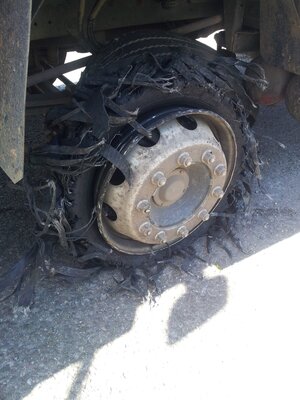I think there is some confusion over what a blow-out is. In a very small nutshell, a blow-out occurs when the pressure in the tyre drops slowly causing friction to heat up the tyre during the course of a journey over a period of time, to the point it literally disintegrates. It's the remnants of the tyre remaining on the wheel which flails against the caravan body causing horrendous damage.
A journey of two miles is not sufficient to cause a tyre to heat up to the point it blows out. I suspect you've suffered a rapid deflation caused by the sharp object piercing the tyre. The problem is, if you are unaware that the tyre on the caravan has deflated, by continuing to drive on it the weight of the caravan will shred the tyre against the road surface and again the ruined tyre will flail the caravan body.
I would definitely recommend to everyone towing a caravan to fit a TPMS such as TyrePal, which warns when pressure is dropping and temperature is rising so you can stop before a disaster occurs.


